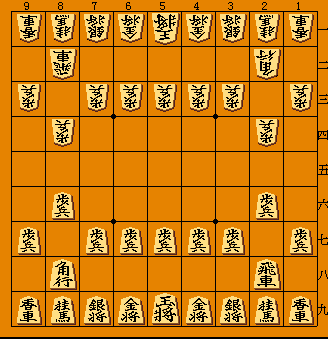Southern Shogi
I don't know when and by whom southern shogi was invented. This variant is well-known to Japanese by another name, but intentionally I don't write the name on the web. I name this rule "southern shogi" in English. This is because the movement of the piece is affected by "southern" piece, as explained in the following description.
Rule
Opening setup of southen shogi is a little different from usual shogi. Four pawns are set on a different places. In the following setup notation, the four pawns are indicated in red characters.

White:
King e1; Gold Generals d1, f1; Silver Generals c1, g1; Knights b1, h1;
Lances a1, i1; Bishop b2; Rook h2; Pawns a3, b4,
c3, d3, e3, f3, g3, h4, i3.
Black:
King e9; Gold Generals d9, f9; Silver Generals c9, g9; Knights b9, h9;
Lances a9, i9; Bishop b8; Rook h8; Pawns a7, b6,
c7, d7, e7, f7, g7, h6, i7.
Movement of pieces
When two pieces of yourself are on neighboring squares in the same file, the movement of "northern" piece (i.e. the piece closer to the opponent's territory) changes to the movement of southern piece. For example, when the white's Gold General is at e1 and the white's Pawn is at e2, the Pawn at e2 moves as gold general. If a King is at a3 and a Pawn is at a2 and a Bishop is at a1 as in the following way,
K
P
B
The King loses its ability to move as King and moves as Pawn, the Pawn loses its ability to move as Pawn and moves as Bishop, and the Bishop does not change its power and moves as Bishop.
The rest of the rules are the same as usual shogi.
Written by Katsutoshi Seki. Image of the opening setup was made with a software made by Yoshikazu Kakinoki.
WWW page created: October 6, 1998. Last modified: November 13, 1998.
